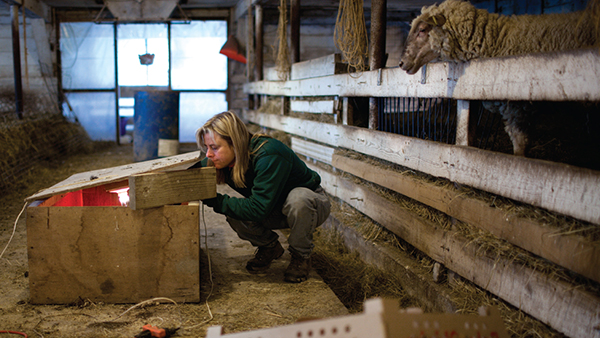
“There are as many ways of looking after poultry as there are fashions in childrearing. Pick a system that suits you and enjoy yourself, ignore the avian mother-in-laws tut tutting away.”
–Francine Raymond, The Big Book of Garden Hens, 2001

While a Tunis cross ewe watches, the author checks on newly delivered chicks she had just placed in a brooding box. A heat lamp keeps the chicks warm as they adjust to their new surroundings.
Starting Your Poultry Enterprise
Early on, when my husband and I first began to raise meat birds, I foolishly tried to spare some of the friendliest ones and keep them as pets. We would fondly refer to these birds as the “Jabbas,” after the grotesque character in Star Wars—their sole purpose in life seemed to be eating, sleeping, and looking slovenly. I knew better than to become attached to what I was raising for meat, but I couldn’t help noticing their individual personalities and their docility. I named one Forrest Gump and another Wendell Berry, after personal heroes. Both chickens were horrendous choices for companions, gullible, devoted, even cuddly, but both were gi-normous, fat beasts that could hardly move.
Once their son grew out of his playhouse and swing set, Carol Steingress and Rick Schluntz converted it into a coop, left, and a winter run for their half-dozen laying hens in Windsor, Vermont. Before they got chickens, Steingress checked to see if the town’s zoning laws prohibited raising chickens in town. It did not, but she and her husband don’t keep a rooster to keep the peace in the neighborhood.
Forrest died of a heart attack after spending nearly eight months as a teacher liaison for migrant workers’ children, where he tried hard to convince the kids that farm animals were friendly. Wendell held on a little longer, but eventually succumbed to bone cancer at the ripe age of two.
When I asked my husband if we could posthumously name our newly acquired farm White Rooster Farm, he looked at me with alarm. “I can’t possibly think why we should pay tribute to these genetic mutants, can you?” So instead, we agreed upon Fat Rooster Farm—a place where we could endeavor to raise our chicken meat and eggs responsibly, with the full understanding of these creatures’ lives and their worth.
We decided to raise the birds using organic methods, to look for varieties that thrived on pasture and wouldn’t self-destruct at a young age. We knew that it would be a challenge. Our laying hens would not lay just brown eggs, but white, pink, green, and mahogany-colored ones. The meat birds would grow more slowly and have bodies that resembled chickens of the 1950s in many respects. Their breasts would have keels (the long, sharp bone where their breast muscles attach under their bellies) and their legs would be long and sturdy to support them in their search to find foods rich in vitamins, minerals, and fatty acids.
It wouldn’t be as rewarding right up front to raise meat and eggs this way, but we would be able to say truthfully that we’d tried to raise the birds humanely and kindly. And eventually, we gained the respect and following of other fellow meat and egg eaters, who value slow food and the knowledge that the animals have been treated compassionately.
Some Considerations Before You Get Started
Local and Federal Regulations
Local laws, such as zoning and other ordinances, may end your chicken enterprise before it takes flight. Some farming magazines have been advertising “Stealth Coops,” mini-pens to conceal your poultry in more urban settings. Besides looking uncomfortable for the chickens (there doesn’t seem to be much space for more than two or three chickens, nor are there sufficient locations for nesting, roosting, and foraging), the idea of concealing your chickens from your neighbors or from town and city officials seems like it will only lead to trouble.
“ The fact that zoning in towns allows residents to raise a barking, crapping dog the size of a small elephant, but not four hens for a steady fresh egg supply shows just how lacking in common sense we have become as a society. The indictment against town chickens stemmed originally from roosters crowing at dawn and waking neighbors. The easy solution to that problem is to raise only hens or butcher the roosters before they mature enough to crow all the time. ”
—GENE LOGSDON in Chicken Tractor, by Andy Lee, 1994
The best way to avoid conflicts is to check with the county zoning board, your extension agent, or the state agricultural department. And after all the rules check out, consult your neighbors with your plan. Are they okay with the accompanying baggage associated with keeping chickens–noise, or an enticement for the dog to chase? Perhaps ruffled neighborhood feathers can be smoothed with the promise of fresh eggs and meat, or the reward of manure high in nitrogen for their garden.
Cloë Milek pets a Dark Brahma Cochin chick in her 2/3-acre in-town yard in Windsor, Vermont. Milek grew up on a farm with chickens and has been raising them with her fiancé for the past seven years. “It’s like therapy,” she said of raising chickens. “It’s very relaxing.”
Two Barred Plymouth Rock pullets, left, and a Partridge Plymouth Rock pullet roam the yard of Carol Steingress and Rick Schluntz. The couple have been raising hens for eggs in their small yard for the past 10 years.
Chicken Scratch
Do I need a rooster to have my hens lay eggs?
No. The rooster is needed if you want a fertile egg but isn’t necessary for a hen to lay eggs.
Do hens lay more than one egg a day?
No. In fact, they will average less than an egg a day in many cases, and their productivity depends on many factors, including age, diet, weather conditions, daylight hours, and breed.
Are all roosters mean?
No, but some breeds have a proclivity toward mean roosters (see breed chart on page 38).
Do roosters only crow at sunrise?
No–they will crow when startled, when they are establishing hierarchy, or simply to announce their territorial presence.
What Type of Chicken Project Interests You?
Before acquiring birds, figure out what you want to accomplish. Chicken fever (a term used loosely to describe someone acting like they’re in a candy store, overwhelmed with the choices of sweets available and ending up with a bellyache instead of a wise choice of one type of candy) is hard to avoid when so many interesting and colorful breeds exist. In reality, each breed of chicken can differ in its specific requirements for food, water, and shelter. A mixed flock may not necessarily do well together. The type of husbandry you have in mind will determine what breed of chicken you decide upon. Answering these questions beforehand will help you determine how chickens will become part of your plan.
• Will the birds be used as a source of eggs and meat for the homestead?
• Do you want to develop a small-scale commercial enterprise?
• Is it easier to market fresh eggs or meat near your farm?
• Are there poultry processing facilities near to you, or do you plan to butcher them yourself?
• Will they be confined to a poultry house, or do you wish to raise them on pasture?
• Are you planning to raise purebred, show-quality poultry?
Generally speaking, then, there are four broad enterprises for raising chickens: for egg production, for chick production to sell locally or to hatcheries, for meat production, or as a hobby (for show or companionship).
How Chickens Are Described
As with other animals and plants, specific terms are used to describe chickens. Breed, class, variety, and strain identify each of the different chickens. For a complete list of breed attributes, including temperament, egg color, hardiness and their primary uses, refer to the Chicken Breed Chart and Key (page 38).
Black Star cross hens perch on a bale of hay in the greenhouse at Luna Bleu Farm in South Royalton, Vermont. Farmers Tim Sanford and Suzanne Long house the chickens in unused greenhouses in winter to give the chickens plenty of light and warmth.
BREED
Breeds of chickens are grouped together according to their size, shape, plumage, number of toes, color of their skin, etc. When mated together, individuals within a breed will produce chicks that share the same characteristics as their parents. Breed recognition can be different, depending on which poultry organization you consult. For example, the Marans is a French breed that is not recognized by the APA (American Poultry Association) because of its inconsistency in type (some Marans individuals in the United States have feathered legs, while others do not), but it is recognized as a distinct breed by the Poultry Club of Britain (PC). On the website www.feathersite.com, there are hundreds of breeds listed that occur worldwide. The APA only recognizes 53 large fowl and 61 breeds of bantams.
CLASS
Breeds are subdivided into classes. In large breeds, classes indicate their origin: American, Asiatic, English, Mediterranean, Continental, and Other (which includes Oriental). Bantam breeds are classified according to characteristics, like comb shape, or presence of feathering on the legs.
VARIETY
Varieties describe breeds based usually on plumage color, but also on comb style or feathering. For example, the Leghorn, in the Mediterranean class, has 12 varieties of large breeds.
STRAIN
A strain is a term that refers to a line of birds that have been bred for specific characteristics. In the show arena, strains are developed from a single breed for characteristics that are thought of as typical or “typy” and are considered superior by the owner and by fanciers of this same breed. There can be several different strains within the same breed. Commercial strains are often hybrids, sometimes having parents of different breeds. These strains are developed for superior production of either eggs or meat. A Cornish-Rock cross is a popular meat hybrid bred to grow heavy breast and thigh meat in a short amount of time. The Black Sex-Link is a laying hen that is crossed with a Barred Plymouth Rock and a Rhode Island Red that can be distinguished as a female from its plumage as a chick.
“ However reluctant those concerned with poultry may be to acknowledge the fact, it is not the less true that most old women who live in cottages know better how to rear chickens than any other persons; they are more successful, and it may be traced to the fact that they keep but few fowls, that these fowls are allowed to run freely in the house, to roll in the ashes, to approach the fire, and to pick up any crumbs or eat all the morsels they find on the ground, and are nursed with the greatest care and indulgence. ”
—SIMON SAUNDERS, from Domestic Poultry: Being a Practical Treatise on the Preferable Breeds of Farm-Yard Poultry, 1868
Foundation versus Composite Breeds
Poultry literature will often refer to chickens as being either foundation or composite breeds. A composite poultry breed is somewhat akin to a crossbred dog such as the Labradoodle, created using a purebred Labrador Retriever (a dog known for its easygoing personality) and the Standard Poodle (a dog known for its brains).
A foundation breed is a very old breed of chicken with distinct characteristics, such as the Dorking, with its five toes. This breed, along with Houdans and Asiatic breeds, was used to develop the composite breed in northern France called the Faverolle. The Faverolle was well adapted to battery cage production, where laying hens were confined in small cages for maximum egg production, and was a good source of winter eggs in the late 1800s.
CHICKEN PERSONALITIES
Behavioral traits among chickens vary widely. The American class contains breeds such as the Rhode Island Red, the Plymouth Rock, and the Jersey Giant that are generally docile, are cold tolerant, and can produce eggs and meat on a small scale. Most of the breeds in the Mediterranean class, like the Leghorn and Minorca, are flighty, smaller bodied, less cold tolerant, but more efficient in converting feed to egg production. The Dorking and Java are both excellent meat breeds, capable of foraging for themselves and requiring less grain, but they will mature more slowly than the Cornish Rock hybrids that are almost entirely dependent on being fed high-quality mixed rations. Dual-purpose breeds refer to those birds that produce enough good-quality meat and sufficient numbers of eggs that they could fit into small-scale operations for home use. It will be important to evaluate the traits of each breed to determine which would be most suitable for your enterprise. Several hatcheries offer assortments of chicks, so you can experiment in your first year or two. It might also be useful to visit neighboring flocks to discuss the pros and cons of the breeds with the flock owner.
1. A Buff Orpington pullet roosts in the enclosed pen outside the coop owned by Cloë Milek and Karl Hanson on their 2/3-acre lot. The couple has been raising 20 hens for eggs for the past seven years. They have avoided keeping a crowing rooster to keep the peace with their neighbors.
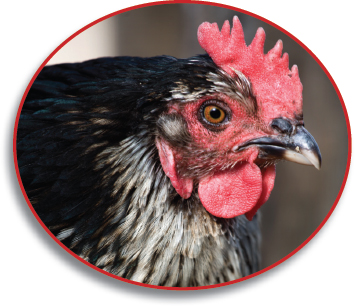
2. A Black Star cross hen basks in the late winter light at Luna Bleu Farm. The farm raises 100 hens for laying eggs and another 60 pullets are growing for their turn in the nesting box.
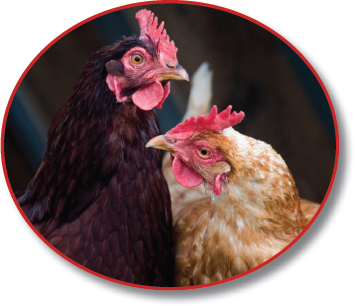
3. A Rhode Island Red hen, left, and a Golden Comet hen look at each other outside of the coop at Back Beyond Farm. Farmer Ray Williams prefers the Comets to the Rhode Island Reds, whom he has seen breaking eggs in the coop.
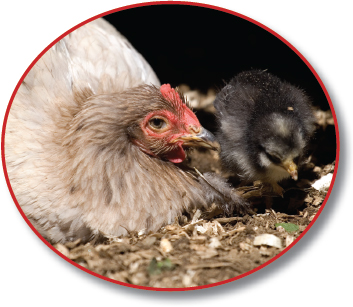
4. While Pistol the Old English Game bantam gives herself a dust bath, one of her chicks explores outside the coop belonging to Cloë Milek and Karl Hanson. Pistol hatched the chicks from fertile eggs Hanson got from a nearby farm.
5. Rosie, a three-year-old Black Sex-Link hen, roams the backyard pen at the home of Geoff Hansen and Nicola Smith. When Hansen bought three pullets from a local farmer for their new coop, Rosie was included as a mentor to teach them the egg-laying ropes.
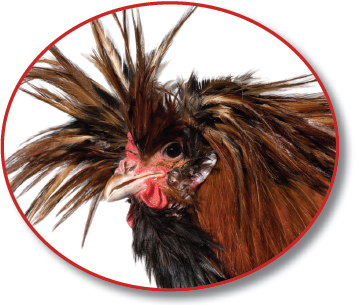
6. Danny, a Polish Crested rooster, is one of a menagerie of birds—including chickens—kept by the author.
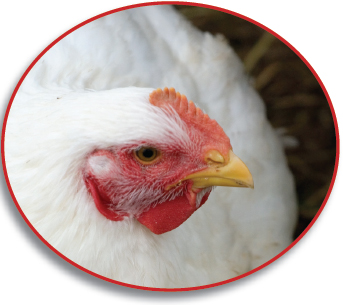
7. A Cornish Rock cross meat bird rests at Back Beyond Farm in Tunbridge, Vermont. Farmer Ray Williams said customers prefer the variety’s abundance of breast meat; the chickens weigh about seven pounds when packaged for sale.
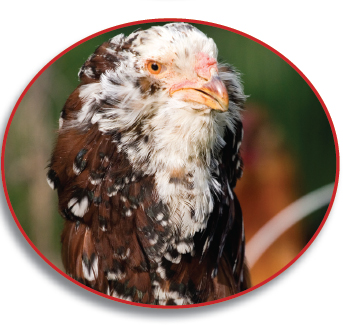
8. With a puff of feathers around its neck and the dark eggs it lays, a Russian Orloff hen is a unique bird. The author was given the bird by someone who was moving away.
Chicken Breed Chart
(See Pages 40–41 for Key)

Chicken Breed Chart Key
The breed chart is a description of the breeds recognized by the American Standard of Perfection as well as some other popular breeds that are as yet unrecognized.
Class refers to the subdivision that large (standard) and bantam fowl fall into. Classifications for standard fowl by the American Poultry Association (APA) indicate their place of origin, while bantams are classified according to specific characteristics, such as comb style, whether they are sport breeds, and may be represented in several different classes depending on variety. The Poultry Club of Britain (PC) distinguishes breeds based on feather type (hard and soft) and body type (light and heavy). Unrecognized breeds are those for which standards of perfection have not yet been determined, but are still considered by some fanciers as distinct breeds.
Breed refers to a group of birds that have similar characteristics, such as size and shape.
Type refers to whether the breed is represented by both large (standard) and bantam body types: l = standard large fowl; b = bantam.
Recognized By indicates if the breed is recognized by the APA, the PC, or is unrecognized to date.
Varieties categories are based on feather color, feather placement, or style of comb. For example, the Plymouth Rock has seven varieties, based on plumage color.
Productivity refers to the egg-laying ability of the breed, relative to other non-commercial breeds: 1 = poor to fair; 2 = good; 3 = excellent. Highly subjective, productivity is easily affected by climate, age, diet, living conditions, and strain.
Egg Color ranges from white (light cream, chalk, to pure white) to brown (light brown to brown); and from dark brown (chocolate brown to mahogany brown) to other (pink, blue-gray, blue, green, or green-gray).
Meat indicates the breed’s relative ability to produce a quality carcass within 8 to 20 weeks of age in comparison to other non-commercial breeds: 1 = poor to fair; 2 = good; 3 = excellent. Color of the skin should also be considered.
Ornamental indicates that certain strains of the breed have been developed for show rather than meat or egg production.
Sport indicates that the strains of the breed have developed for sport historically.
Temperament is classed as f = flighty, based on behavior or (as in some crested breeds) the ability to be startled because of plumage covering their eyes; a = aggressive, meaning protective of flock, behavior within the flock, or to humans; d = docile. All are relative classifications and may not address individuals within each breed.
Hardiness is classed as c = relatively tolerant of cold; w = tolerant of warmer climates; t = do best in temperate zones.
Broodiness rates the tendency to incubate laid eggs and set on them to hatching: 1 = good brooder; 2 = moderately broody; 3 = non-setter.
Comb Type is based on APA standards: single, rose, spiked rose, cushion, pea, walnut, strawberry, buttercup, or vee-combed.
Skin Color refers to the skin color underneath the bird’s feathers: s = slate; b = bluish; w = white; y = yellow; b = black.
Availability in United States is based on twenty hatcheries in the U.S. (see appendix for list of hatcheries): c = common; u = uncommon; r = rare; na = not available readily.
Conservation Status refers to the breed’s overall status, based on the American Livestock Breed Conservancy (ALBC): c = critical, with fewer than 500 breeding birds, and five or fewer primary breeding flocks in North America; r = rare, with fewer than 1,000 breeding birds, and seven or fewer primary breeding flocks in North America; w = watch, with fewer than 5,000 breeding birds and 10 or fewer primary breeding flocks in North America; s = study, breeds that are of interest but lack either definition or historical documentation; re = recovering, breeds that have recovered from the other categories but still need monitoring; co = common, breeds that are not considered by ALBC to be in danger of extinction.
Chicks can be hatched under a hen by saving eggs from your fertile flock (meaning there are roosters running freely with the hens). Fertile eggs can also be purchased and placed under a broody hen or in an incubator. Most commonly, chicks are purchased as day-olds that are mailed and delivered within 24 to 48 hours, but hatcheries usually require a minimum order to keep the chicks warm during shipping. Females that are close to beginning egg production, called started pullets, are probably most economical if you are interested in production as early as possible. In rural areas, local newspapers and agricultural magazines often advertise laying hens at a free or reduced cost. Show-quality birds are offered by breeders in fanciers’ magazines, at poultry shows, or on the Web. Appendix Two lists specific poultry breed clubs that you can contact for more breed specific information; Appendix Four lists hatcheries that sell a variety of breeds. The American Standard of Perfection, published by APA (www.amerpoultryassn.com), should be consulted for specific characteristics for each breed recognized by the organization.
Before introducing new stock to an existing flock, the birds should be quarantined and given a clean bill of health from a veterinarian or a knowledgeable poultry producer. The National Poultry Improvement Plan (NPIP) maintains a directory of hatcheries and breeders that are enrolled in blood-testing programs for detection of several diseases that are contagious to poultry. The voluntary program was started in the 1930s as a means of eliminating pullorum disease from commercial poultry. Not all breeders are willing to wade through the red tape of bureaucracy, however, and you could always have your state extension agent do the testing on the birds that you are interested in purchasing (see Appendix Three).
Hatching Chicks with Broody Hens
One of the most exciting processes to observe is that of a hen transforming her eggs to fluffy chicks just by sitting on them for 21 days. Tracking the development of the embryo by candling the egg and watching the hen as she keeps vigil on the nest provides a magical quality to raising your own flock.
Before you can hatch the eggs, however, you need a hen that still has the maternal urge to become broody. A broody hen is one that has laid a nest or clutch of eggs and has begun sitting on them (setting) with the intention of hatching. Once the hen becomes broody, she will cease to lay eggs and will not resume laying until her chicks have reached independence (the age of independence varies according to breed). A broody hen will readily accept eggs that are given to her even if they have been laid by other hens.
The maternal instincts that take over in hens that become broody are impossible to predict reliably. Some breeds still carry excellent broodiness genes, such as the Silkie and heavy, docile breeds like the Cochin, Plymouth Rock, Orpington, and Rhode Island Red. Many commercial breeds of layers have been carefully selected over several years to lay continuously without turning broody, and some of the lighter, more flighty breeds like Leghorns and Minorcas are not known for their broodiness.
A broody hen needs to incubate her clutch of eggs for 21 days before they hatch. The eggs are nestled under her against a featherless patch of skin on her breast called a brood patch. Normally a feathered area on her body, the hormones of broodiness cause her to loose feathers on her belly, creating direct contact with the skin and acting to incubate the eggs. She turns the eggs several times each day so that the embryo inside the egg does not stick to the shell membrane. She will become very protective, ruffling her feathers on her back and emitting a shrill, shrieking sound if approached too closely. Broody hens will leave the nest unattended for short periods of time only in search of food and water and to eliminate waste. Care should be taken not to position water and food too closely to the nest, as it could attract attention to the nest site and will decrease her needed exercise (don’t make it impossible for her to feed herself, though).
Broody hens should be disturbed as little as possible. Some poultry keepers suggest lifting the hen off her nest daily to eat, drink, and defecate. I have not experienced a broody hen incapable of regulating her needs by herself, and the constant disturbance might cause her to abandon her nest before the job is done. If you don’t like where she has set up house and want to move her onto new eggs, let her brood in the spot she has chosen for at least three or four days. Move her to the new spot at night, taking care to give her some trial eggs, and see if she continues to stay broody. Make sure that her new nest is far enough away from the spot she originally chose, or she may return to it after a trip for food and water. After a couple of days, you can substitute the new eggs that you intend to hatch.
The number of eggs to set under the broody hen will vary by breed. A Plymouth Rock can easily incubate ten eggs, but a Cochin bantam may only be able to incubate three large-breed eggs or five to seven bantam eggs. The fact that the hen will now end up setting for more than 21 days in total won’t be a problem; I once had a hen that sat on a mudpie for two months before I finally intervened. It is more important to be sure that a hen that is broody will stay interested in setting on the eggs until they hatch.
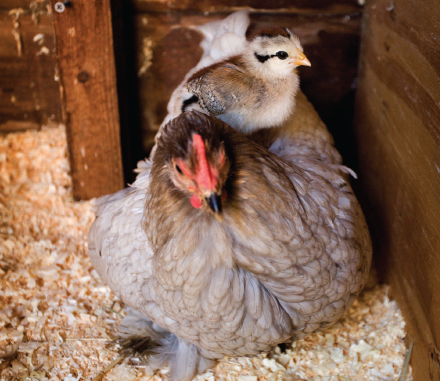
Pistol, an Old English Game bantam, rests in the coop while one of her chicks scales her back. Karl Hanson gets fertile eggs from a nearby farm to be hatched out by the family’s brooding hens. “I enjoy seeing what comes out,” Hanson said.
Autumn, a Bantam Partridge Rock hen, walks with two chicks she hatched from fertile eggs brought in from a nearby farm by Karl Hanson. Hanson and his fiancée, Cloë Milek, have been raising chickens in their 2/3 acre in-town yard for the past seven years.
Only hens in good physical condition should be allowed to carry out incubation of a clutch. The energy demands required can threaten the life of the hen if she is in poor condition and decrease the likelihood that her chicks will reach maturity.
Breeds that are good brooders and mothers are not necessarily top egg or meat producers. Australorps, Brahmas, Old English Game Hens, Sussexes, Cochins, Frizzles, and Silkies make excellent broody hens and are often kept as surrogate mothers with breeds that are considered non-setters.
Broody hens typically need to be separated from other layers, as they will readily accept new eggs such that hatch dates will become unsynchronized.
Broody hens need to be safe from predators, and they tend to “hide” their nests (keep them concealed from other hens, predators, and the flockkeeper). If one of your hens goes missing, try to catch her on her trip to food and water, then follow her back to her nest.
Inexperienced setters will sometimes abandon the nest before the eggs hatch, or set on the eggs to try and hatch every last one, even if they’re infertile, causing the demise of the first hatched. Broody hens need to be closely supervised for maximum success of the clutch.
After the eggs have hatched, the brood should be moved to an area free of predators and competition with other poultry for food and water. Chicks should be supplied with chick starter, but access to plenty of fresh, natural food will greatly add to the health of the chicks and the mother (see Chapters Three and Four).
PRODUCING FERTILE EGGS
If you’ve just decided to let the hen that has become broody hatch her own eggs, you won’t need to worry about selecting eggs for her to hatch. If your goal is to maintain a particular breed or improve your flock’s quality, however, you should consider which eggs to set under your broody hen.
Don’t be tempted to select eggs for incubation just because they look pretty. Above all else, the most important consideration for selecting the eggs you use to hatch should be the breeding stock. Because fertility is an inherited quality in the individual hen, the hatchability of the egg can be improved by selecting the most fertile hens–those that are healthy, young, lay uniformly shaped eggs, and are observed being mated by the rooster. You should keep no more than 11 hens per rooster to ensure fertility, and the flock should be observed daily. Chickens are not monogamous, though roosters will pick favorite hens, and some individuals within the flock may not lay fertilized eggs.
Stock used to produce fertile eggs should be given a diet called a breeder ration that is fortified with vitamins and minerals (see Chapter Four). Ideally, access to the outdoors and insects, worms, and greens will greatly benefit the birds.
Chickens don’t have external sexual organs. Instead, the hen and rooster have the same anatomy, called a cloaca, where the sperm is transferred from the rooster to the hen in what is called a cloacal kiss. A sure sign that the rooster has been mating a hen is broken or missing feathers on her back and on the back of her neck. This happens when the rooster holds onto her neck with his beak and jumps on her back, referred to as treading. Treading causes the hen to drop her neck to the ground, lifting her tail for mating. Sperm can last inside the hen’s reproductive tract for up to 20 days, although its viability drops sharply after 7 to 10 days. Chickens will mate throughout the year, anytime during the day, but some poultry experts claim that mating is more frequent in the afternoon, when there is less of a chance that an egg is obstructing the way for sperm to reach the mature ova.
A “Barnyard Classic” chick, one of mixed heritage, ducks under a tarp in the barn. The chick was hatched by a broody Silkie hen in the farm’s barn.
Breeding birds should have access to at least 14 hours of light daily. Light stimulates the pituitary gland to secrete the hormones responsible for making a hen lay her eggs. Light also increases the semen output in the rooster. An inexpensive timer from the hardware store can be set to provide light prior to sunset and again before sunrise. In the northern United States, our layers are given artificial light beginning in mid-October through April. Don’t forget to check the timer after power outages, use energy-efficient bulbs, and reset the timer after daylight savings begins and ends.
Boyfriend, a “Barnyard Classic” mixed heritage rooster, looks out the barn window. The farm’s roosters fertilize eggs that are hatched by hens or an incubator.
Eggs from pullets and old hens should not be incubated. Porous shells (where light leaks through tiny holes in the egg upon candling, revealing differences in the shell’s thickness) and abnormally large, small, or misshapen eggs should all be avoided. Cracked eggs will seldom hatch. If you are new to this, choose eggs that can be easily candled (white or lightly tinted).
The hatching eggs that you choose should be clean, although don’t wash them as this can remove the cuticle or bloom that protects the shell, and can allow more rapid evaporation within the egg. Store the eggs between 50 and 68 degrees Fahrenheit in egg cartons or flats, with the small end of the egg pointed down. Keeping the eggs for two to three days prior to incubating is ideal, but if they are held longer than seven to ten days, they are less likely to hatch. This is because eggs have genetically adapted to a hen’s habit of leaving the nest after each egg has been laid so that development is arrested until the clutch is complete and the hen begins incubating full-time. Keeping the eggs longer than ten days in an artificial environment such as an egg carton will cause a decrease in hatchability. There is no need to turn the eggs prior to incubation unless you’re keeping them for longer periods of time.
Finally, when you are ready to begin incubating the eggs under your broody hen, place each egg under her by cupping your hand protectively over it (broody hens guard their nest aggressively, and as you slip the eggs under her, she can inadvertently peck and crack the egg; if you’re concerned about getting pecked, wear a glove). If your broody hen accepts the eggs by continuing to incubate them, mark your calendar for the grand hatch in 21 days!
The Completed Egg
A hen’s egg is a perfect living environment for the fertilized embryo it contains (if, in fact, roosters have been with the hens). The yolk contains the blastoderm, or germ that the sperm has penetrated. In the 24 hours it takes for the egg to be laid, this fertilized single cell has divided into hundreds of cells that provide the foundations for the development of organs and tissues that make up the chick. The egg contains an adequate food supply and a covering that protects the embryo during its development. It even provides the newly hatched chick with nourishment to hold it safely under its brooding mother while its siblings hatch over the next 24 hours.
CANDLING EGGS
Candling is an ancient term coined from the practice of holding the flame of a candle up to an egg to check its fertility. After 72 hours at a temperature as little as 102 degrees Fahrenheit, an intricate web of blood vessels is formed within the egg and is visible by shining a light through the shell. Eggs set under broody hens or in incubators should first be candled at a week or 10 days of age (the period at which the first critical embryo die-off occurs). White eggs are the easiest to candle; a spiderweb of vessels around a dark spot is a healthy embryo. If you see no webbing, and the egg is clear, the egg is probably infertile. Eggs should be candled a second time at about 14 to 17 days. By this time, a distinct air space at the large end of the egg can be seen, and the rest of the egg will be dark. If the egg looks muddy, and the edge of the air space jiggles or is uneven, the embryo has most likely died. All infertile or dead eggs should be removed as soon as possible to avoid them bursting and soiling the viable eggs. You can usually hold the egg up to your ear at about 20 days and hear the chick peeping or pecking from inside the egg.
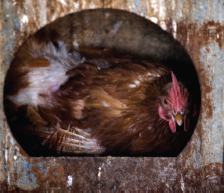
A Golden Comet hen gets to work in a nesting box. The Golden Comet is a popular commercial egg-layer.
A penlight or flashlight held up to the large end of the egg in a dark room will suffice as a candler, or you can make a device easily at home. We typically use a paper towel or toilet tissue cardboard insert. Cut the roll to about 3 inches, then place the egg, wide-end down, on the roll. Shine the light source up through the bottom. The air cell is clearly visible in an egg that has a developing embryo, and sometimes the embryo itself can be seen moving in the egg.
Using an Incubator to Hatch Eggs
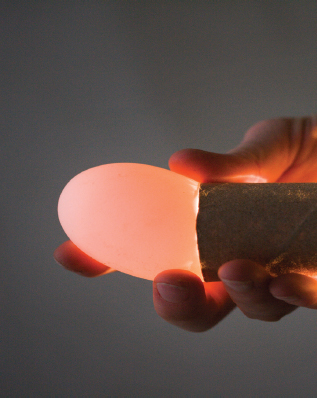
Using a flashlight underneath a paper towel roll, the author shines light through an infertile egg.
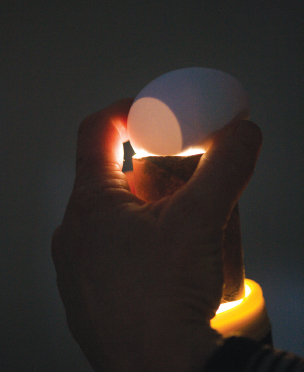
Using a flashlight underneath a paper towel roll, the author shines light through a fertilized egg—an air pocket shows up in the egg.
Incubators have several advantages over naturally hatching your chicks. First, you can time the hatch; you don’t have to wait until a hen becomes broody. Second, you can hatch several more eggs at once with much less labor than it would take to hatch the eggs under broody hens that need individual attention, food, and water. Whether the broody hen will set on the eggs until they hatch is also a concern. Last, incubators are a great way to bring the joy of raising chicks into the home.

Chicken Scratch
As early as 360 BC, people have claimed that the shape or size of an egg can be used to determine the sex of the embryo inside. Aristotle, the ancient Greek philosopher, claimed that elongated eggs yielded male chicks. About 300 years later, Pliny the Elder argued that the opposite was true. In truth, about 50% of the eggs that hatch will be males—what do you plan to do with them if you are interested in a laying flock, or they are not a quick-maturing meat type? Finding a home for roosters is hard, but as science and technology grows by leaps and bounds, we may soon be able to determine the sex of chicks before the egg hatches. Until then, you should consider a plan B.
Descriptions exist of both the Chinese and the Egyptians hatching chicks by artificial means centuries before Christ’s birth, in the time of Moses, by the ancient priests in the Temple of Isis. The Egyptians used sun-dried brick structures heated by fires, where the eggs were placed on grates in heated chambers. There were no thermometers in these chambers; the attendants who lived inside the incubators could sense the correct temperature to keep the fires. As many as 90,000 eggs could be incubated at a time, for 15,000,000 to 20,000,000 hatched yearly. Eggs were tested for fertility by placing them on the palm of the hand or against the face; if the egg was cold, it was discarded. In China, smaller ovens were used. The French used wine casks, packed with horse manure and circulated hot water, over which eggs were placed to artificially incubate; and in England, hot air was passed through flues and over the eggs to hatch chicks. But it wasn’t until the early 1900s that incubators could boast hatching as high a percentage of chicks as could a setting hen. Modern incubators incorporate climate-controlled heat and humidity to simulate conditions that would naturally occur. Eggs are mechanically turned, and hatches are normally at least 80% successful. Incubators for home use can be purchased for small- or large-scale hatches with built-in turning devices and thermostatic controls (see Appendix Four). I prefer incubators with automatic turners, as it cuts down the time needed to open the incubator, reducing the risk of unstable temperature or humidity conditions inside.
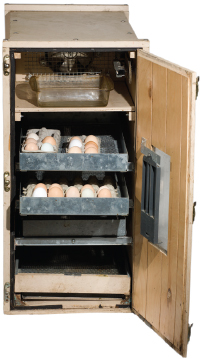
Incubators should be placed in a location where temperature and humidity will not fluctuate wildly. Even though these conditions are regulated, the thermostat inside the incubator can’t compete with drafts, temperature spikes from artificial heat sources, or unnaturally dry or wet conditions. Placing a thermometer that reads minimum and maximum temperatures in different areas of the house or barn may help choose the ideal spot for the incubator.
Typically, internal temperatures in the incubator are kept at 99.5 to 102 degrees Fahrenheit, depending on whether it is a forced-air (where a fan blows the air and circulates the heat within), a still-air, or a natural-draft (where air follows gravity within) incubator. Humidity is very important for a hatch to be successful. If too humid, the eggs will not evaporate moisture adequately, and the chicks will hatch with mushy navel disease (see Chapter Ten). Not enough humidity will cause the egg’s inner shell to dry out and make it impossible for the chick to break out of the shell. I have always found this part of incubation the trickiest, and how the mother hen can pull it off without a hitch 95% of the time remains a marvel. Humidity should increase right before the hatch, and opening and closing the incubator near hatching can have marked effects on hatching success. Incubators are equipped with separate water tanks that are filled to supply humidity inside. The larger the surface area of the container, the more potential there is for higher humidity.
A thermometer with both a dry bulb and a wet bulb is the best way to determine relative humidity in the incubator. The wet bulb has a wick that is positioned over the end of the thermometer and placed in a reservoir of water (the bulb itself does not touch the reservoir of water). Relative humidity can be determined by finding the difference between the two readings. A dry bulb reading of 99.5 degrees Fahrenheit with a corresponding wet bulb temperature of 88 or 89 will result in a relative humidity of about 65%. This is adequate until the last three days of hatching, when the relative humidity should increase to 85% (the wet bulb should now read about 95). You can increase humidity by decreasing the airflow into the incubator (close some of the vents), or by increasing the size and surface area of the water container inside the incubator. Always follow the manufacturer’s instructions for your incubator and make minor adjustments depending on your conditions.
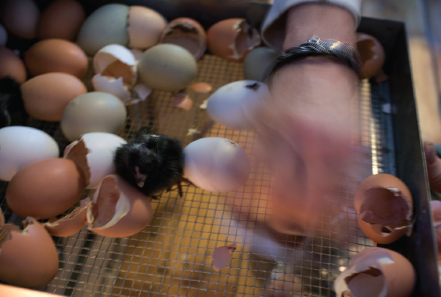
The author removes hatched chicks from an incubator to a brooder box.
A crude alternative to having a wet and dry bulb thermometer to determine the correct humidity inside the incubator is measuring the relative size of the air cell within the egg. This is done by candling the egg and comparing it to a standardized diagram of what the air cell should look like at a specific time of development. Humidity can be decreased or increased, depending on the size of the air cell with relation to the age of the embryo.
Setting the Eggs for Hatching in an Incubator
The eggs you choose to hatch in the incubator should be selected using similar criteria for those hatched under a broody hen. They should be similar in size, dirt and crack free, of the same age, and have the classic egg shape: wide at the top, tapering to a rounded point. The shape of the egg is important for the developing chick inside. In order to hatch unencumbered, the chick must develop with its head facing toward the wide end of the egg and the air cell. Eggs that are not uniform in size and age will prolong the hatch and increase the chance of embryo death.
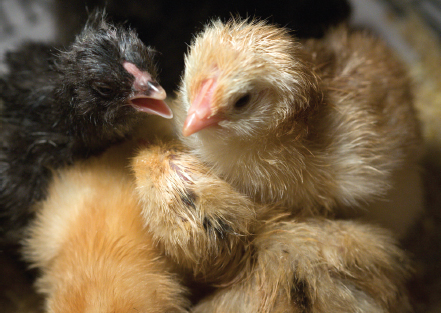
“Barnyard Classics”—newly hatched chicks of mixed heritage—cheep and chatter while under a heat lamp.
Eggs should be placed and maintained within the incubator according to manufacturer’s instructions. It’s always a good idea to set up and run your incubator without the eggs in it for at least 12 to 24 hours to make sure everything is operating properly.
If you are not using an automatic turner, it is useful to make an X with a Sharpie marker on one side of the egg so you can keep track of which side it has been turned on. In the nest, eggs are turned as much as every 20 or so minutes. Manually, turning them three times a day is sufficient. Three days prior to hatching, the eggs should stop being turned. If you’re using one, take the automatic turning device out and place the eggs on their sides in the incubator’s tray. By remaining stationary on the incubator’s shelf, the chick can position its beak correctly along the egg’s shell. If you can, allow plenty of room between the eggs on the shelf, so that when the chicks hatch they don’t knock into the other eggs.
PROBLEMS WITH THE INCUBATOR
Ideally, an uninterrupted power source should be used with the incubator. If you don’t have one, the best thing to do if a power outage occurs is to mimic the conditions that are present when the setting hen leaves her eggs to eat, drink, and defecate. Open the incubator and let the eggs cool. This will also avoid the possibility of suffocation, now that the ventilation fan is not running. Usually, if power is restored within 12 hours, it will not affect the embryos. Make sure to check the temperature within the incubator after an outage, because the thermostatic wafer, filled with ether, may have been affected. It is always a good idea to keep an extra wafer and thermometer on hand when using an incubator (these can be purchased through the same supplier that you purchased your incubator from).
Ventilation within the incubator is also important. Without proper airflow, the unhatched embryos can suffocate. As the hatch approaches, the need for ventilation increases. Unfortunately, increased airflow can decrease humidity. A humidifier placed in the room that holds the incubator can help, or water reservoirs within the incubator can be increased.
Degrees Difference Between Wet and Dry Bulb

In a cardboard box in the living room, a newly hatched chick sits under a heat lamp after it emerged from its egg in an incubator.
Stages of Hatching
As the hatch date approaches, conditions in the incubator become more critical. While the hatch is occurring, the incubator should be disturbed as little as possible to keep temperature and humidity consistent. The embryos are easily chilled, and their chances of hatching will be compromised if you open and close it too much.
Live embryos within the eggs begin vocalizing as much as 24 hours before they break free from the egg’s shell. Close examination of the egg will reveal tiny cracks, radiating from a point somewhere along the widest part on the egg. This is called the star crack. Eventually, the crack turns into a small hole. This stage is called pipping. Closer investigation will reveal the tiny beak of the chick armed with its special egg-cracking tool, the egg tooth. The chick uses the egg tooth to make the series of breaks along the eggshell, and eventually, it uses its legs to push the small end of the egg away and bursts from the shell, wet and tired. Chicks are hatched with enough nutrients to take them through 24 to 48 hours without additional food or water. In this way, the hen can naturally and safely set on her clutch, allowing the last of the eggs laid to hatch. In the incubator, shells should be removed quickly from the hatching tray, and chicks should be placed on the bottom shelf to avoid injury or jostling of unhatched eggs. Chicks can be removed from the incubator when they are dry (about 18 to 24 hours after hatching) and kept in a brooding pen with a heat lamp that maintains a temperature of 95 degrees Fahrenheit at a height of 17 inches from the floor of the pen. If the hatch is prolonged, remove the chicks to the brooder (see Chapter Three) every 8 to 10 hours and provide them with food and water.

THE PERILS OF ARTIFICIAL HATCHING
It is day four of the hatch. Our incubator is an ancient one, and because of that, along with the drafty farmhouse conditions, our–10-degree-Fahrenheit nights, and the fact that our hens are different ages and not in their breeding prime, our hatch has dragged out longer than desirable. I have set the eggs in order to have chicks to show to a class of children before February break, so the hatching conditions are neither perfect, nor ones in which I would normally choose to set eggs. I announce to my son that it is time to pull the plug on the remaining unhatched eggs. He lets out a shriek of protest and gallops over to the incubator to stop my hand.
At eight years old, he is all boy. He breaks tree branches in mock swordsmanship; the cats are terrorized by his flying leaps onto their sleeping forms for “snuggling.” He pulverizes the burdock plants along the barn’s length, and rotten pumpkins are reduced to glistening mounds of orange, putrid pulp. I am apprized of flies that have succumbed to the pencil sharpener or the woodstove, and tomato hornworms become gooey globs of green that often bespeckle his clothes and face. With the exception of the hornworms, these antics receive sharp denouncements from me, his mother, who for his last birthday bought him a piñata shaped like a cactus, because the thought of allowing a band of eight-year-olds to beat animal or human shapes to smithereens was reprehensible.
With the chicks, he is different. On the day we were to open the incubator and remove the dry chicks to the brooding box, he woke up 30 minutes early. On the following morning, while the newly hatched chicks waited out an Arctic front in a box in our living room, he tiptoed down the stairs to keep from waking us and gingerly held their cottonball forms on his lap. Each one was quickly identified according to color or peep pitch. And each was held with the dread that it would become a rooster and eventually end up in our freezer.
So now we are upon the hour, time to stop the incubator. We pull out the remaining eggs and carefully hold each to our ear, listening, searching, and hoping for signs of life. In the end, 70% of our eggs hatch. Not bad for the odd assortment of eggs that we had set. We carefully investigate each of the unhatched eggs, identifying what traits they had that might have contributed to their demise: not the right shape, too large, too small, a hairline crack that had not been noticed before. Then, we collect the remaining eggs and compost them. We unplug the incubator, and sit, delighted at the whirling dervishes in the brooder box that chase after each other’s toes, beaks, and scattered pieces of grain. I hope they’re all hens, he murmurs. I secretly smile, thankful for my chicken-sensitive son.
Bradford Jones, 9, gets an up-close view of a newly hatched chick that was hatched by incubator.
The most popular method of starting a flock is by purchasing day-old chicks from an established hatchery. Only chicks that are healthy are shipped, avoiding the problems associated with malfunctioning incubators and inexperienced broody hens that don’t tend to their chicks. Often, chicks are offered as sexed rather than straight-run (these are unsexed chicks that are more than likely 50% males). This option is especially nice if you’d rather not bother with dispensing with the cockerels once they’ve grown. Remember, free roosters are not exactly a sought-after luxury item.
Chicks are shipped the day of the hatch and arrive within 48 hours by U.S. Postal Service. Mark your calendar the day before expected delivery, so that the brooder is ready for the new arrivals, and you don’t find yourself hunting for the heat lamp and waterers when the post office calls you.

Chicken Scratch
Don’t feed the shells of hatched chicks to your chickens. Throw them in the compost. Be sure that children handling the chicks and their hatched shells wash their hands thoroughly after handling them. They are loaded with bacteria and feces from the embryo.
If all the conditions are maintained correctly in the incubator, hatches of up to 85% can be achieved. A normal hatch takes about 24 hours.
In rural areas, the USPS is no stranger to the arrival of chicks in the mail. Our local postmistress, Gloria, calls me the minute they arrive in our tiny town, regardless of the early-morning hour. Even locked, the secret chick knock on their front door brings the box of peeping babies out to the lobby. Visit your post office and warn them of the chick’s imminent arrival, and give them reliable phone numbers for where to reach you. If your central distribution center is close, as ours is, you could even ask them to phone you. It may mean the difference between chicks spending the night just 25 miles away because they’ve missed the ride before the close of your rural post office, and most postal workers would just as soon have the noisy things taken away. Make sure to inspect your package right there in the lobby, and if need be, fill out a claim form for any dead chicks (most hatcheries have specific requirements that need to be met in order to qualify for reimbursement).
The author picked up a mixture of Bard Silver cross chicks and Plymouth Rock cross chicks from the South Royalton Post Office. The farm raises batches of 100 to 150 chicks every six weeks in the summertime to sell to customers for their meat.
Lucy, a three-month-old Buff Orpington/ Plymouth Rock cross pullet, roams the backyard pen at the home of Geoff Hansen and Nicola Smith. Hansen found the ten pullets online and drove across the state to buy them for himself and a nearby friend.
A Cuckoo Marans hen, top, and an Ameraucana cross hen get a view of the morning from a barn window. The farm has 50 laying hens, producing two to four dozen eggs a day.
For anyone considering keeping chickens primarily as a laying flock, partially grown birds may be the best option. Although they don’t tend to be as tame as chicks that have grown up in your flock, they are more economical in the long run. Hens don’t typically begin laying eggs until at least 20 weeks of age, and some of the heritage or dual purpose breeds may take six or seven months before laying. During this time the average chicken bred for commercial production of eggs will eat 15 pounds of feed, while the slower-maturing, heavier-bodied birds may eat as much as twice that amount. Mortality is not as high in started birds as it is in chicks you’ve hatched or purchased.
Be sure to buy started birds from reputable breeders who know the importance of feeding young laying hens correctly and who maintain well-kept, disease-free flocks.
Free Chickens
The papers are full of free chickens, mostly roosters, but sometimes layers, always claiming to be just a year old. As enticing as they may seem, try and avoid free chickens unless you know the person giving them up. First, chickens are rarely just a year old if they are being given away. More important is the risk of introducing some sort of disease into your chicken yard. Otherwise healthy-looking chickens can harbor anything from lice to scaly leg mite (see Chapter Ten). Usually, unless there has been a tragedy in the family, the reason to unload chickens is because they no longer serve a useful purpose to their owner.
One of Fat Rooster Farm’s hens takes a look at newly delivered chicks that had been placed in a brooding box. When the lid is closed, a heat lamp keeps the chicks warm as they adjust to their new surroundings.